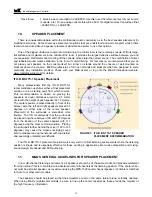
By combining a carefully designed low frequency acoustic rolloff of all the main speakers, including the
surrounds, and a matching 2nd order electronic filter in the M&K Bass Management Controller, M&K achieves all
the theoretical benefits of a 4th order Linkwitz-Riley filter. In addition, to further create a seamless bass managed
system, we use only non-ported sealed cabinet designs on all our speakers and subwoofers, eliminating ported
speaker phase anomalies which would prohibit smooth transitions at the bass managed crossover frequency.
Another good reason for using bass management in the control room is that even the least expensive Dolby
Digital consumer decoder, found in millions of homes, has bass management built in, allowing the bass from all
channels to be fed to a single subwoofer. Also, all Home THX systems utilize an 80Hz bass management system.
Monitoring with proper bass management in the professional control room insures proper playback translation into
the "home theater" environment and into larger spaces such as motion picture theaters.
It is important to understand that Bass Management is done as a function of the monitoring system and in no
way affects the actual mix. Full frequency musical content, is assigned or panned around the room via normal
console or software operations to the various desired subjective locations such as Left, Center, Right, Left
Surround, and so on. This full frequency musical data corresponding to each speaker location channel is stored
normally on tape, hard drive, etc.
Bass Management psychoacoustically works because the ear-brain mechanism cannot detect direction at low
frequencies, but takes its directional cues from the harmonics of the low frequency sound. In the monitoring
process, frequencies below 80Hz are redirected to the subwoofer. Frequencies above 80Hz are sent to the desired
speaker. During the hearing process, our hearing mechanism integrates the sound into the correct spatial
auditory image.
Bass management is equally suited to all formats from 2-channel stereo to 5.1 and beyond. Indeed, existing
control rooms that are doing stereo 2 channel mixes, especially with smaller nearfield monitors placed on the
console, can benefit immensely from the correct integration of Bass Management and a subwoofer; because the
engineer is now able to hear low frequency anomalies caused by room rumble, microphone stand thumping, breath
pops, and other artifacts that cause undesirable actions later in the broadcast, film chain, or DVD Mastering
process.
When mixes are intended for theatrical presentation, it is sometimes necessary to use an additional channel
for extra low frequency effects or enhancement.
This channel is called the LFE or Low Frequency
Effects/Enhancements channel. In the control room monitoring environment, the LFE channel, if or when it is used
in the mix, is monitored by the same subwoofer used for the regular [L,C,R,LS,RS] channels.
M&K Bass
Management Controllers have both a 0dB (with unity gain) and +10dB (with 10dB gain) inputs to accommodate
any mixing / monitoring situation, as per Dolby specifications.
The M&K Professional Division supplies, at no additional charge, a special CD test disc to assist in the
proper setup and calibration of our Bass Management Systems. This disk has pre-filtered and calibrated tracks of
noise which allow quick, accurate, and error-free setup of the monitoring environment to the Dolby standard of
85dB SPL, or any other relative reference level, by using an SPL meter.
4.
INTRODUCTION
The LFE-4 Bass Management Controller is a balanced, line-level studio bass management controller which is
intended for use with the M&K line of professional studio monitors. Although the LFE-4 was primarily designed for
monitoring 5.1 audio, its flexible architecture allows it to be used for monitoring mono, stereo, Dolby Surround,
Dolby Digital, DTS and other formats.
The LFE-4 combines several necessary functions in one 19” rack mount, 1RU package. Along with bass
management and LFE channel control, it also provides individual channel adjustment capability to properly
calibrate your entire monitor system.
Bass Management Controller
5
Содержание LFE-4
Страница 16: ...LFE 4 manual PN 70360 7 08 2003 rev 1 pt qrk...


































